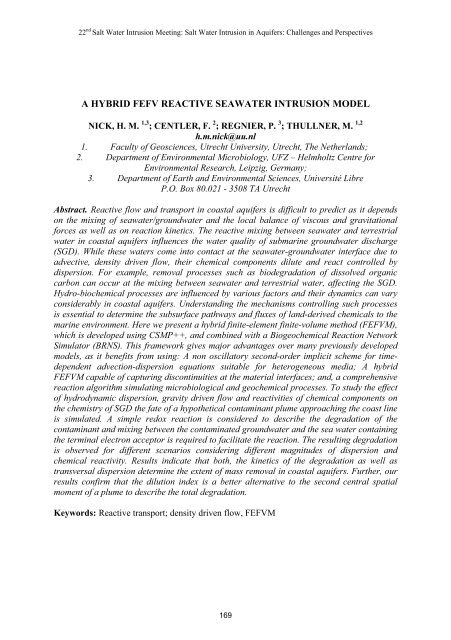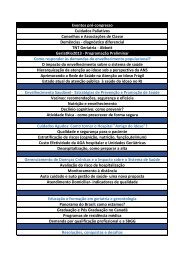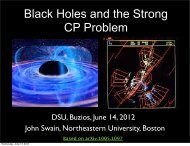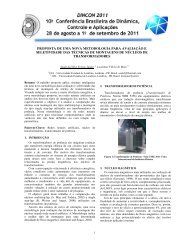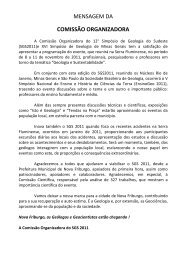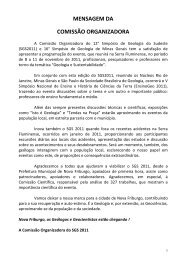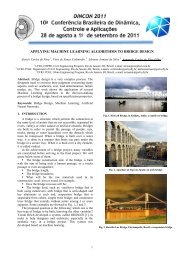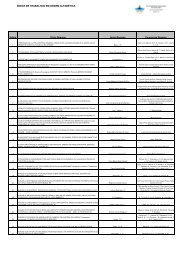Here - Meta Marketing e Eventos
Here - Meta Marketing e Eventos
Here - Meta Marketing e Eventos
- No tags were found...
Create successful ePaper yourself
Turn your PDF publications into a flip-book with our unique Google optimized e-Paper software.
22 nd Salt Water Intrusion Meeting: Salt Water Intrusion in Aquifers: Challenges and PerspectivesA HYBRID FEFV REACTIVE SEAWATER INTRUSION MODELNICK, H. M. 1,3 ; CENTLER, F. 2 ; REGNIER, P. 3 ; THULLNER, M. 1,2h.m.nick@uu.nl1. Faculty of Geosciences, Utrecht University, Utrecht, The Netherlands;2. Department of Environmental Microbiology, UFZ – Helmholtz Centre forEnvironmental Research, Leipzig, Germany;3. Department of Earth and Environmental Sciences, Université LibreP.O. Box 80.021 - 3508 TA UtrechtAbstract. Reactive flow and transport in coastal aquifers is difficult to predict as it dependson the mixing of seawater/groundwater and the local balance of viscous and gravitationalforces as well as on reaction kinetics. The reactive mixing between seawater and terrestrialwater in coastal aquifers influences the water quality of submarine groundwater discharge(SGD). While these waters come into contact at the seawater-groundwater interface due toadvective, density driven flow, their chemical components dilute and react controlled bydispersion. For example, removal processes such as biodegradation of dissolved organiccarbon can occur at the mixing between seawater and terrestrial water, affecting the SGD.Hydro-biochemical processes are influenced by various factors and their dynamics can varyconsiderably in coastal aquifers. Understanding the mechanisms controlling such processesis essential to determine the subsurface pathways and fluxes of land-derived chemicals to themarine environment. <strong>Here</strong> we present a hybrid finite-element finite-volume method (FEFVM),which is developed using CSMP++, and combined with a Biogeochemical Reaction NetworkSimulator (BRNS). This framework gives major advantages over many previously developedmodels, as it benefits from using: A non oscillatory second-order implicit scheme for timedependentadvection-dispersion equations suitable for heterogeneous media; A hybridFEFVM capable of capturing discontinuities at the material interfaces; and, a comprehensivereaction algorithm simulating microbiological and geochemical processes. To study the effectof hydrodynamic dispersion, gravity driven flow and reactivities of chemical components onthe chemistry of SGD the fate of a hypothetical contaminant plume approaching the coast lineis simulated. A simple redox reaction is considered to describe the degradation of thecontaminant and mixing between the contaminated groundwater and the sea water containingthe terminal electron acceptor is required to facilitate the reaction. The resulting degradationis observed for different scenarios considering different magnitudes of dispersion andchemical reactivity. Results indicate that both, the kinetics of the degradation as well astransversal dispersion determine the extent of mass removal in coastal aquifers. Further, ourresults confirm that the dilution index is a better alternative to the second central spatialmoment of a plume to describe the total degradation.Keywords: Reactive transport; density driven flow, FEFVM169


